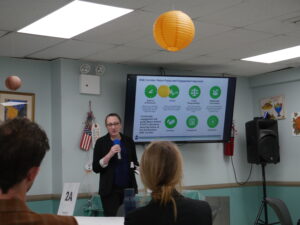By Oona Milliken | omilliken@queensledger.com
The Brooklyn-Queens Expressway, also known as the BQE, is long past its lifespan. Now, the highway is due for an overhaul, led by the Department of Transportation.
The DOT has launched a three-part series of community meetings for the Central, North and South parts of the BQE. The third and final workshop series for BQE North and South ran from Oct. 30 to Nov. 8 and allowed for DOT officials, community members as well as designers, engineers and architects of the redesign gathered to discuss the future of the BQE. Julie Bero, Chief Strategy Officer for the DOT, said in an interview that the new administration was focused on bringing unheard voices to the forefront of the conversation.
“This administration is really focused on equity, which I think has been really inspiring to me. In the past, a lot of focus has been on the city or portion, which is in one of the wealthier neighborhoods in the city. And so we’re saying, ‘No, we’re gonna look at the full corridor here,’” Bero said. “I think we’ve gotten good feedback, that was really welcome. There are a lot of communities that haven’t been listened to or engaged for a long time.”
During a Oct. 30 meeting in Williamsburg, Bero said that the DOT has three timelines in which the department is organizing the redesign.
One, a short term project timeline for ideas that might be implemented in the next few years, such as bike lanes along the highway, street improvement initiatives, repaving, and building pedestrian plazas. These projects are all covered by DOT funding and would not require additional state funds.

DOT’s Chief Strategy Officer Julie Bero speaking at a BQE North meeting. Photo credit: Oona Milliken
Two, a medium timeline with projects like moving the curb line, adding rain gardens or street trees or constructing new larger plazas with lighting, benches and other amenities.
Lastly, the DOT’s third timeline is of long-term projects that will require city, state and federal coordination to complete. According to Bero, these might include building “caps” across the BQE on which parks, housing or pedestrian bridges might be built.
Solveig Entwistle, a Williamsburg resident who attended the workshop, said she appreciated the community feedback sessions and is excited to get some of the smaller changes to the BQE started as soon as possible. Entwistle said she wanted to see short-term changes implemented as the BQE redesign begins, rather than waiting decades to see an impact.
“My biggest hesitation is the fact that it might take decades to deck over. I would rather see something this year, or in 2024,” Entwistle said. “Much of the things that they were talking about, they are long term goals, which are absolutely important to have, but I would like to see paint on the street on a small portion where the city actually controls rather than having to engage with state conversations and work with the federal government.”
Kevin LaCherra, a transportation and road safety activist based in Greenpoint, said he was also most concerned with the shorter term projects, particularly those that minimize street accidents. LaCherra also said he was interested in decreasing parking and contributing LaCherra similarly.
“With DOT and WXY they’ve been listening to a lot of folks in the community through the process,” LaCherra said. “We want policies implemented as soon as possible, around things like daylighting, safe intersections, the reimagining of the parking fields to be public amenities, public spaces, the narrowing of the roadway to knit the community back together.”
DOT has hosted another previous two rounds of workshops hosted in both North and South Brooklyn prior to this most recent series. As this one concluded on Nov. 8, a community input report will be drawn up and released by spring 2024. According to the DOT’s website, the department is investing $500,000 into garnering community input into the redevelopment ahead of any construction. Bero said the local organizations, funded by the DOT, have conducted over 100 community engagement events.


